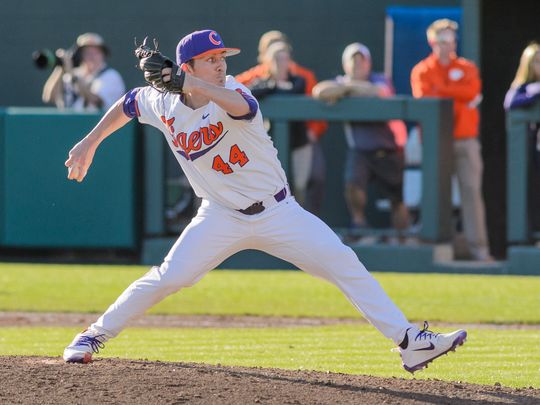
Ryley Gilliam/David Grooms Independent Mail
Round 5, Pick 140 – Ryley Gilliam
Ht: 5’10” Wt: 170 lbs DOB: 8/11/1996
School: Clemson
Stats
2018 (Junior): 38 IP, 1.41 ERA, 11 Saves, 1.15 WHIP, 22 BB, 54 K
2017 (Sophomore): 35 IP, 2.57 ERA, 4 Saves, 1.23 WHIP, 14 BB, 50 K
2016 (Freshman): 31 IP, 6.10 ERA, 0 Saves, 1.42 WHIP, 18 BB, 16 K
Background
Coming out of high school, Gilliam’s commitment to Clemson was a factor in his going undrafted. Three years later, the Mets would give Gilliam a $550,000 bonus ($170,600 over the pick’s $379,000 value) to entice him to leave Clemson.
Originally a starter, Gilliam’s role was permanently shifted to the bullpen during his freshman year. Gilliam’s continued success in the relief role lead to him becoming Clemson’s closer as well as pitching for USA Baseball’s Collegiate National Team (where he did not allow an earned run in 8 1/3 innings), and in the Cape Cod league that summer.
Scouting
Gilliam was ranked 127 on MLB Pipeline’s Top 200 Prospect Watch, and 207 in Baseball America’s top 500 Draft Prospects. Thoughts that his athleticism will make him a durable reliever, despite his size, seem to be the reason for the disparity between the two rankings.
Baseball America notes that Gilliam has two main pitches: a fastball that works 91-96, and a hard, high-spin curve that sits in the high-70’s that he uses at the corners, or buried in the zone. They attribute’s Gilliam’s velocity to “lighting-quick arm speed.” Perfect Game has clocked Gilliam as high as 97 MPH.
MLB Pipeline writes that Gilliam has a high-tempo delivery that adds some “funk,” but it has also led to some control issues. Noting as well that Gilliam also has an effective changeup that has seen less use as a reliever than when he was a starter.
Development
All sources seem to agree that Gilliam’s two plus pitch arsenal will make him a quick-riser through the minors in a relief role. In fact, MLB.com‘s Jim Callis named Gilliam as one of five players from the 2018 draft who could reach the majors first.
The main concern with Gilliam is his ability to repeat his delivery to the plate, and tangentially, control of his pitches. In his collegiate career, Gilliam saw a continuous increase in walks. On the bright side, this also coincided with a decrease in the number of hits he allowed (7.46 H/9 in 2017 to 5.17 H/9 in 2018).
His curveball is a definite plus out-pitch that left college-level hitters in helpless. As he progresses and locates it more consistently, it should be an even more lethal weapon for him. Despite some control issues, his arsenal is good enough to keep hitters off-balance and induce weaker contact. For example, Gilliam gave up just five home runs in his entire collegiate career.
A true athlete, Gilliam should be able to adjust his motion slightly while improving both his fastball and curveball. With a noted high-floor, Gilliam has the stuff to be a back-end of the bullpen reliever not too far into the future.

